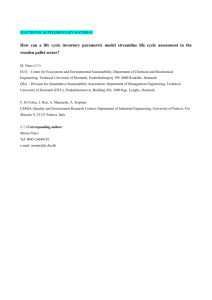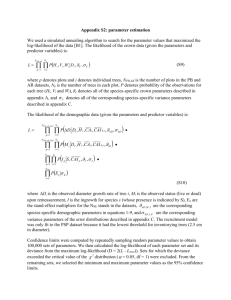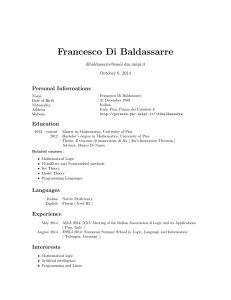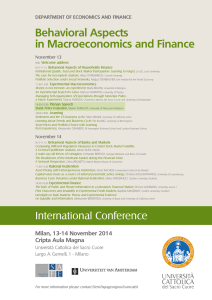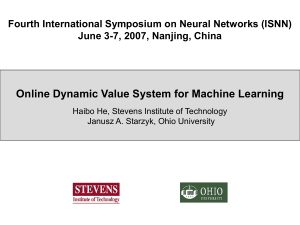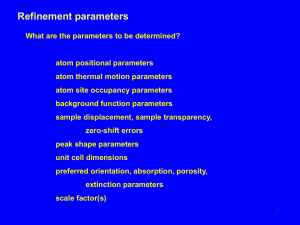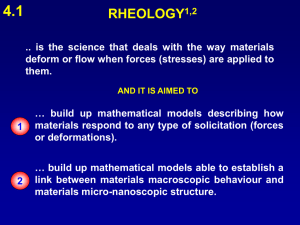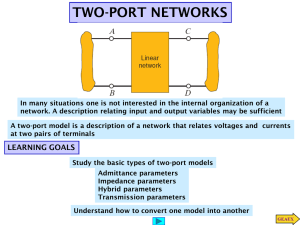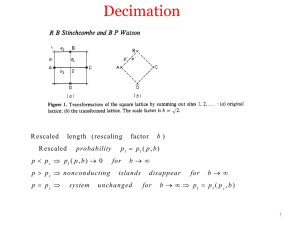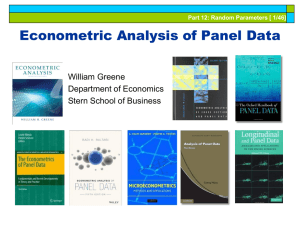MATHEMATICAL MODEL IS
advertisement
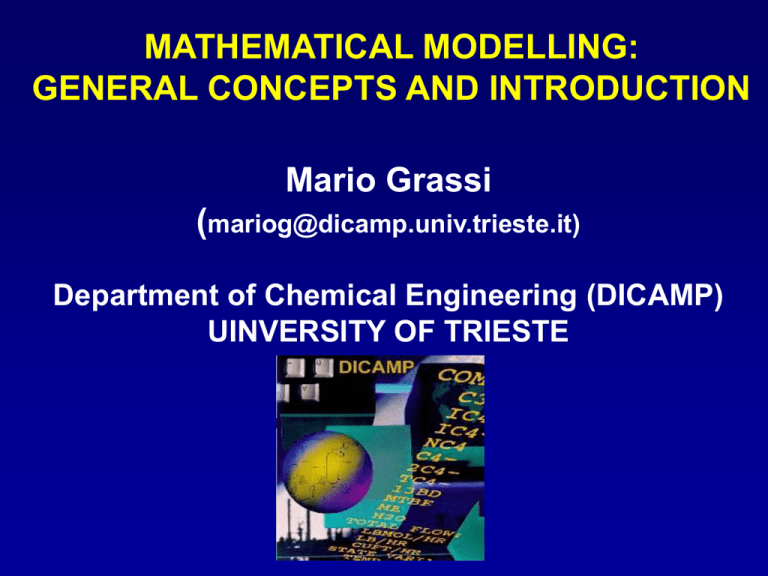
MATHEMATICAL MODELLING: GENERAL CONCEPTS AND INTRODUCTION Mario Grassi (mariog@dicamp.univ.trieste.it) Department of Chemical Engineering (DICAMP) UINVERSITY OF TRIESTE WHAT IS A MODEL? [1] AN ARTIFICIAL REPRESENTATTION OF SOMETHING NEEDED FOR VISUALIZE SOMETHING THAT CAN NOT BE DIRECTLY OBSERVED (MOLECULE) IMITATION OR EMULATION OF SOMETHING CONSEQUENTLY, MODELLING IS A COGNITIVE ACTIVITY AIMED TO THE DESCRIPTION OF HOW PHENOMENA OCCUR OR OBJECTS BEHAVE KNOWLEDGE MODELLING CAN BE PERFORMED ACCORDING TO: 1 SKETCHES 2 PHYSICAL MODELS 3 DRAWINGS 4 MATHEMATICS Leonardo da Vinci Y f (X , Z) C 2 DC K Cs C t MATHEMATICAL MODEL IS A MATHEMATICAL METAPHOR OF SOME ASPECTS OF REALITY [2] (DRUG RELEASE AND ABSORPTION) “... niuna umana investigazione si può dimandare vera scienzia, s’essa non passa per le matematiche dimostrazioni” Leonardo da Vinci, Trattato della Pittura 1651 MANY DIFFERENT FIELDS CAN TAKE ADVANTAGE OF MATHEMATICAL MODEL 1 4 PHARMACY 5 BIOLOGY 6 MEDICINE 7 PSYCHOLOGY ENGINEERING 2 PHYSIC 3 CHEMISTRY [3-5] WHY NOT TYPICAL IN BLUE FIELDS (4-7) CULTURAL REASONS PRACTICAL REASONS HUMAN MIND CATEGORISATION OF KNOWLEDGE Field 1 no no Field 2 no no Field 3 no [1] no Impermeable barriers hindering transversal tools diffusion INTRINSIC COMLEXITY OF PHARMACEUTICAL BIOLOGICAL MEDICAL PSYCHOLOGICAL PHENOMENA Phenomenon analysis Physical hypotheses Reliable Model Identification of the mechanisms ruling the phenomenon Mathematical hypotheses Definition of proper experiments aimed to check the hypotheses: NO Mechanisms mathematical form and assembling to get the MODEL MODEL comparison with EXPERIMENTAL DATA: FITTING OK MODEL comparison with EXPERIMENTAL DATA: PREDICTION OK NO MATHEMATICAL MODEL EXPRESSION Y = f(Z1, Z2, ….Zn, A1, A2, ….Am) dependent variable Independent variables EMPIRICAL A1, A2, ..Am do not posses a physical meaning Y A0 t * A1 Linear relation Model parameters: Z1, Z2, … Zn independent THEORETICAL A1, A2, ..Am do posses a physical meaning SC0 D A1 A2 A3 Y Mt t * Z1 h A4 C0 donor D receiver C=0 h MODEL FITTING PARAMETERS SOME MODEL PARAMETERS ARE KNOWN … A1, A2, A4 in the previous example Y Mt SC0 D AA A t 1 2 3 * Z1 h A4 C0 donor D receiver C=0 h …THE REMAINING ARE UNKOWN AND ARE CALLED FITTING PARAMETERS AND NEED TO BE DETERMINED A3 in the previous example Y Mt SC0 D AA A t 1 2 3 * Z1 h A4 MODEL DATA FITTING EXPERIMENTAL DATA Cr(t) DIFFERENCE [Cr experim – Cr model] MODEL t t1 t2 C 2 i 1 i 6 t 3 t4 i r exp erim C i t5 t6 i r mod el Standard deviation 2 i 2 1 N xj x N 1 j 1 Statistic tells us that the most probable set of model parameters (A1, A2, … Am) is that yielding the lowest 2 value IS THE FITTING SATISFACTORY? y y σ 2 N MSR i 1 MSR F MSE i 2 i MSE M 1 2 N M Mean Square Error degrees of freedom n2 = N-M Mean Square Regression degrees of freedom n1 = M-1 N y 2 y σ i i i 1 N 2 1 σ i i 1 yi y i i 1 N 2 Mean p i 2 M = model fitting parameters number N = experimental data number n1 = n 1 1 2 3 4 5 6 7 8 9 10 11 12 13 14 15 16 17 18 19 20 21 22 23 24 25 26 27 28 29 30 40 60 120 161.4 18.51 10.13 7.71 6.61 5.99 5.59 5.32 5.12 4.96 4.84 4.75 4.67 4.60 4.54 4.49 4.45 4.41 4.38 4.35 4.32 4.30 4.28 4.26 4.24 4.23 4.21 4.20 4.18 4.17 4.08 4.00 3.92 3.84 2 3 4 5 6 7 8 9 10 12 15 20 24 30 40 60 120 Theoretical F values with n 1 (numerator) and n 2 (denominator) degrees of freedom fixing p = 1 – = 0.95 (F[n 1,n 2,p]) 199.5 19.00 9.55 6.94 5.79 5.14 4.74 4.46 4.26 4.10 3.98 3.89 3.81 3.74 3.68 3.63 3.59 3.55 3.52 3.49 3.47 3.44 3.42 3.40 3.39 3.37 3.35 3.34 3.33 3.32 3.23 3.15 3.07 3.00 215.7 19.16 9.28 6.59 5.41 4.76 4.35 4.07 3.86 3.71 3.59 3.49 3.41 3.34 3.29 3.24 3.20 3.16 3.13 3.10 3.07 3.05 3.03 3.01 2.99 2.98 2.96 2.95 2.93 2.92 2.84 2.76 2.68 2.60 224.6 19.25 9.12 6.39 5.19 4.53 4.12 3.84 3.63 3.38 3.36 3.26 3.18 3.11 3.06 3.01 2.96 2.93 2.90 2.87 2.84 2.82 2.80 2.78 2.76 2.74 2.73 2.71 2.70 2.69 2.61 2.53 2.45 2.37 230.2 19.30 9.01 6.26 5.05 4.39 3.97 3.69 3.48 3.33 3.20 3.11 3.03 2.96 2.90 2.85 2.81 2.77 2.74 2.71 2.68 2.66 2.64 2.62 2.60 2.59 2.57 2.56 2.55 2.53 2.45 2.37 2.29 2.21 234.0 19.33 8.94 6.16 4.95 4.28 3.87 3.58 3.37 3.22 3.09 3.00 2.92 2.85 2.79 2.74 2.70 2.66 2.63 2.60 2.57 2.55 2.53 2.51 2.49 2.47 2.56 2.45 2.43 2.42 2.34 2.25 2.17 2.10 236.8 19.35 8.89 6.09 4.88 4.21 3.79 3.50 3.29 3.14 3.01 2.91 2.83 2.76 2.71 2.66 2.61 2.58 2.54 2.51 2.49 2.46 2.44 2.42 2.40 2.39 2.37 2.36 2.35 2.33 2.25 2.17 2.09 2.01 238.9 19.37 8.85 6.04 4.82 4.15 3.73 3.44 3.23 3.07 2.95 2.85 2.77 2.70 2.64 2.59 2.55 2.51 2.48 2.45 2.42 2.40 2.37 2.36 2.34 2.32 2.31 2.29 2.28 2.27 2.18 2.10 2.02 1.94 240.5 19.38 8.81 6.00 4.77 4.10 3.68 3.39 3.18 3.02 2.90 2.80 2.71 2.65 2.59 2.54 2.49 2.46 2.42 2.39 2.37 2.34 2.32 2.30 2.28 2.27 2.25 2.24 2.22 2.21 2.12 2.04 1.96 1.88 241.9 19.40 8.79 5.96 4.74 4.06 3.64 3.35 3.14 2.98 2.85 2.75 2.67 2.60 2.54 2.49 2.45 2.41 2.38 2.35 2.32 2.30 2.27 2.25 2.24 2.22 2.20 2.19 2.18 2.16 2.08 1.99 1.91 1.83 243.9 19.41 8.74 5.91 4.68 4.00 3.57 3.28 3.07 2.91 2.79 2.69 2.60 2.53 2.48 2.42 2.38 2.34 2.31 2.28 2.25 2.23 2.20 2.18 2.16 2.15 2.13 2.12 2.10 2.09 2.00 1.92 1.83 1.75 245.9 19.43 8.70 5.86 4.62 3.94 3.51 3.22 3.01 2.85 2.72 2.62 2.53 2.46 2.40 2.35 2.31 2.27 2.23 2.20 2.18 2.15 2.13 2.11 2.09 2.07 2.06 2.04 2.03 2.01 1.92 1.84 1.75 1.67 248.0 19.45 8.66 5.80 4.56 3.87 3.44 3.15 2.94 2.77 2.65 2.54 2.46 2.39 2.33 2.28 2.23 2.19 2.16 2.12 2.10 2.07 2.05 2.03 2.01 1.99 1.97 1.96 1.94 1.93 1.84 1.75 1.66 1.57 249.1 19.45 8.64 5.77 4.53 3.84 3.41 3.12 2.90 2.74 2.61 2.51 2.42 2.35 2.29 2.24 2.19 2.15 2.11 2.08 2.05 2.03 2.01 1.98 1.96 1.95 1.93 1.91 1.90 1.89 1.79 1.70 1.61 1.52 250.1 19.46 8.62 5.75 4.50 3.81 3.38 3.08 2.86 2.70 2.57 2.47 2.38 2.31 2.25 2.19 2.15 2.11 2.07 2.04 2.01 1.98 1.96 1.94 1.92 1.90 1.88 1.87 1.85 1.84 1.74 1.65 1.55 1.46 251.1 19.47 8.59 5.72 4.46 3.77 3.34 3.04 2.83 2.66 2.53 2.43 2.34 2.27 2.20 2.15 2.10 2.06 2.03 1.99 1.96 1.94 1.91 1.89 1.87 1.85 1.84 1.82 1.81 1.79 1.69 1.59 1.50 1.39 252.2 19.48 8.57 5.69 4.43 3.74 3.30 3.01 2.79 2.62 2.49 2.38 2.30 2.22 2.16 2.11 2.06 2.02 1.98 1.95 1.92 1.89 1.86 1.84 1.82 1.80 1.79 1.77 1.75 1.74 1.64 1.53 1.43 1.32 253.3 19.49 8.55 5.66 4.40 3.70 3.27 2.97 2.75 2.58 2.45 2.34 2.25 2.18 2.11 2.06 2.01 1.97 1.93 1.90 1.87 1.84 1.81 1.79 1.77 1.75 1.73 1.71 1.70 1.68 1.58 1.47 1.35 1.22 254.3 19.50 8.53 5.63 4.36 3.67 3.23 2.93 2.71 2.54 2.40 2.30 2.21 2.13 2.07 2.01 1.96 1.92 1.88 1.84 1.81 1.78 1.76 1.73 1.71 1.69 1.67 1.65 1.64 1.62 1.51 1.39 125 1.00 MODEL COMPARISON: AKAIKE CRITERION1 χ2 M 1N 2 AIC N ln 2 N M 2 N N = number of experimental data M = number of fitting parameters The most probable model is that characterised by the smallest AIC The probability of being right is defined by: e 0.5 pAIC ; 0.5 1 e AICom AICsmallest EXAMPLE: IF = 2 =====> pAIC = 0.73 MODEL EVALUATION: PREDICTION FITTING UNKNOWN MODEL PARAMETERS (FITTING P.) Y = f(Z1, Z2, ….Zn, A1, A2, ….Am) Cr MODEL PREDICTION EXPERIMENTAL DATA t IS MODEL PREDICTION SATISFACTORY? YES E.D. STD. DEV. MODEL PREDICTION Cr EXP. DATA MODEL STD. DEV. t MODEL STD DEV IS CALCULATED ASSUMING FITTING PARAMETERS SETS THAT MAXIMISE AND MINIMISE PREDICTION: Ai = value ± S.D. ROBUST FITTING EXP. DATA Traditional Fitting d4 Cr(t) MODEL EXP. DATA d2 MODEL d6 d5 d3 d1 t1 t2 C 2 i 1 i 6 t3 t 4 i r exp erim t5 t6 C i i r mod el 2 t1 t2 t3 t4 di i 1 i i 6 2 t5 2 t6 EXAMPLE 1: SLIDING SLAB Y FRICTION (FR = b*M*v) FM FM X FR t=0 HEAT due to friction (WRINKLED SURFACE) MODEL: NEWTON EQUATION dV Ma M FM b M V dt SLAB MOTION CAN BE SIMULATED POSITION, VELOCITY, ACCELERATION, TEMPERATURE 0.7 25 0.6 POSITION 0.5 15 v(m/s) x(m) 20 10 0.4 VELOCITY 0.3 0.2 5 0.1 0 0 10 20 30 0 40 0 10 t(s) 30 40 t(s) 0.12 0.01 0.1 ACCELERATION TEMPERATURE PROFILE 0.008 y(m) 0.08 a(m/s2) 20 0.06 0.006 0.004 0.04 0.002 0.02 0 0 0 10 20 t(s) 30 40 25 25.5 26 T(°C) 26.5 27 Energy(J) 25 Supplied Lost Kinetic 20 15 10 5 0 0 5 10 15 20 25 30 Power(w) t(s) 0.7 0.6 0.5 0.4 0.3 0.2 0.1 0 Supplied Lost Kinetic 0 5 10 15 t(s) 20 25 30 EXAMPLE 2: HUMAN MEMORY [6] Stimulus vp Performance Sensory buffer kr(d) kj+1(d) kj(d) kj-1(d) k1=d pi pPi pRi STS r j+1 j j-1 B u ff e r 1 pPi 1 e I t retrieval pRi t*/n I LTS d 1 i i 1 k r r 1 j j 1 mij f(r,d,t,q) Model fitting parameters mij FREE VERBAL RECALL TEST [7] 48 young subjects (19-28 years old) are asked to remember a list containing twelve items (word) each (8 repetitions) Vp = 0.5 item/s exp i p # Corrected remembrance position " i" # Corrected remembrance position "12" exp 12 p 1 1.2 1 0.8 p 0.6 0.4 0.2 experimental model best fitting simulation simulation simulation 0.25 item/s 0.5 item/s 1 item/s 2 item/s 0 0 1 2 3 4 5 6 7 8 9 10 11 12 13 item presentation order r = 3; = 1.75; t = 0.76; d = 0.27 Fitting parameters REFERENCES 1. Grassi, M., Grassi, G., Lapasin, R., Colombo, I. Understanding drug release and absorption mechanisms: a physical and mathematical approach. CRC, Boca Raton, Florida, USA, 2006. 2. Israel, G. Balthazar van der Pol e il primo modello matematico del battito cardiaco, in Modelli matematici nelle scienze biologiche, Freguglia, P. Ed., Edizioni Quattro Venti, 1998. 3. Dym, C. L. Principles of Mathematical Modeling, 2nd edition, Elsevier Academic Press, San Diego, London 2004. 4. Bourne, D. W. A. Mathematical Modeling of Pharmacokinetic Data, Technomic publishing CO., INC., Lancaster, Basel, 1995. 5. Cartensen, J. T. Modeling and data treatment in the pharmaceutical sciences, Technomic publishing CO., INC., Lancaster, Basel, 1996. 6. Atkinson, R. C. and Shiffrin, R. M., Human memory: A proposed system and its control processes, in The Psychology of Learning and Motivation: Advances in Research and Theory, Spence, K. W. and Spence J.T. Eds., Academic Press, 1968 7. Peirano, F. Rievocazione libera e interpretazione della curva di posizione seriale negli anziani, Tesi di Laurea, Università di Padova, Dipartimento di Psicologia, Giugno 2000. 8. Grassi, M., Voinovich, D., Moneghini, M., Franceschinis, Perissutti, B., Filipovic-Grcic, J. Preparation and evaluation of a melt pelletised paracetamol stearic acid sustained release delivery system. Journal of Controlled Release 88 (2003) 381–391.
